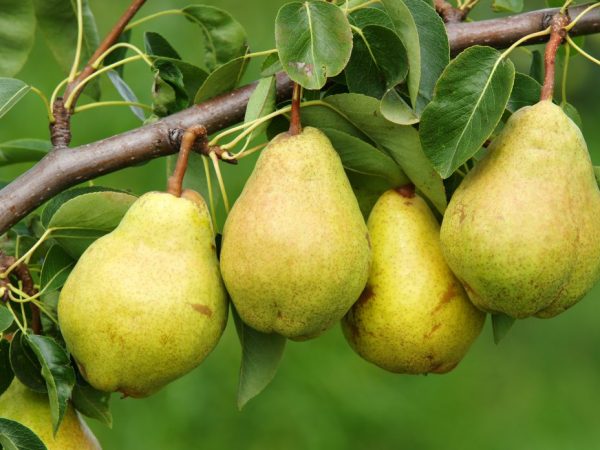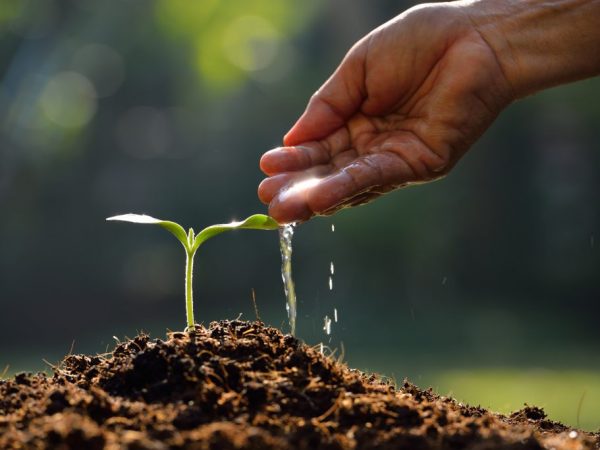Characteristics of the pear variety Fabulous
Pear Fairy is a flying pear variety. If you adhere to the cultivation technology, then already 2 years after planting, the culture will delight you with its fruits.

Characteristics of the pear variety Fabulous
Variety characteristic
The flowering period of the Fairy Pear falls in the second half of May and lasts until mid-June. The tree begins to bear fruit in the second half of August.
According to the description of the Skazochnaya pear variety, the culture is highly fertile. In the 2nd year after planting, the tree already gives a good harvest (up to 3 kg), and in 4-5 years, up to 10 kg of fruits can be harvested from one tree.
It is advised to store fruits after harvesting for up to 10 days. Then the pulp turns brown.
Description of the tree
The height of the tree reaches 4 m. The trunk of the tree is dark brown, with slight peeling.
The crown is rather thick, pyramidal in shape. The branches on the trunk are densely arranged, directed upwards. Leaves are oval, small in size and with a sharp edge.
Description of fruits
The fruits of this crop are medium in size. Weight varies from 180 to 200 g. For 4-5 years after planting, they can reach 250 g.
The fruit has the correct pear-shaped shape. The skin is quite dense and tough, therefore it is recommended to peel it before use. Its color during the ripening period changes from green to yellow with a slight blush.

The fruits are tasty and have a pleasant aroma.
The description of the fruit pulp is as follows:
- white;
- oily consistency;
- very juicy.
The fruits are tasty and have a pleasant aroma. You can eat them fresh, as well as squeeze juice from them, cook jam and compote.
Care
A fabulous pear needs quality care. To obtain high yields, it is very important to carry out a number of timely agrotechnical measures:
- digging up the soil near the plant;
- weed removal;
- correct moderate watering;
- frost protection;
- constant feeding;
You also need to carry out sanitary pruning of the crown 2 times a year. During pruning, dry or damaged branches must be removed. Those that do not bear fruit are also pruned. Cut off places must be treated with garden varnish.
Planting seedlings
When buying a seedling, you need to inspect it. Pay attention to the roots, in no case do not purchase a seedling with signs of rot.
You need to plant a tree so that the neck of the seedling is flush with the ground. Because the pear of this variety does not tolerate a strong planting depth.
After the work done, the plant needs to be watered and sprinkled with dry earth on top. The landing site must be chosen not swampy. Excessive humidity can cause many diseases.
The plant needs to be watered periodically all summer after planting. For the winter, cover the tree with snow to protect it from rodents.
Top dressing
For good growth and development, the plant needs to be fed. When choosing fertilizers, you need to consider:
- plant age;
- season;
- soil type;
- individual characteristics of growth.
The fruit tree can be fed by starting with planting a seedling.A little manure is put in the hole, mixed with the soil. This helps to strengthen the root system of the culture.
During the digging of the trunk circle near the tree, peat is introduced into the soil. Then the ground near the plant is watered so that the roots are saturated with useful substances.

A fabulous pear needs quality care.
In the spring, the tree is fertilized with nitrogen fertilizers. They are of great benefit during the growing season. Also, phosphorus and potash fertilizers are used with nitrogen fertilizers (in a ratio of 3: 4: 1).
More attention should be paid to feeding the crop 2 years after planting. At this time, it requires a lot of nutrients that are contained in fertilizers.
Diseases and pests
The main advantage of this species is resistance to various diseases. Sweet pear variety Fabulous does not damage scab, gall mite, black cancer, as well as fungal diseases. But due to improper care, the tree can hit:
- Soot fungus. This disease damages the leaves and fruits of the pear. On them you can find a black coating that resembles soot. This disease primarily affects weak trees and those lacking minerals. This fungus is not afraid of winter. He hides under the bark of a tree. Insects are the main carriers of the sooty fungus. To prevent the disease, you need to use the insecticide "Calypso", and for treatment - the fungicide "Fitoferm".
- Powdery mildew. On the inflorescences and leaves of the tree, you can notice a powdery white bloom, which after a while becomes a reddish hue. Damaged parts dry out and fall off. The prevention of this disease is the removal of damaged leaves and their subsequent burning. Gardeners also use folk remedies - they spray the tree with a 1% solution of potassium permanganate.
- Moniliosis or fruit rot. Fruits become covered with brown growths and lose their flavor. It is very difficult to notice this disease on fruits, as it manifests itself during the ripening period. Damaged fruits dry on the tree or sprinkle. To prevent the disease, the plant should be treated with lime solution in spring and autumn (1:10).
Particular attention should be paid to the quality of the work done against these diseases. After all, they can harm the tree and affect fruiting.
Conclusion
The Fazochnaya pear variety is very popular. The fruit is very resistant to various diseases and pests, therefore it does not require constant spraying. The only drawback is the short storage time.


